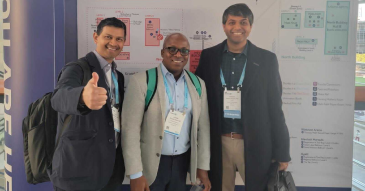IONIXX TECH NEXUS
HealthTechThe Role of Machine Learning in Medical Decision-Making
The Role of Machine Learning in Medical Decision-Making
 Newsletter
NewsletterU.S. healthcare is in a financial crisis, and patients feel it acutely. Nearly 90 million Americans are a part of Medicaid, the public health insurance program for low-income groups. Medical bills are a leading cause of bankruptcy, as 100 million Americans remain saddled with medical debt.
Today, healthcare professionals use AI-enabled devices and platforms every day, from performing robot-assisted joint replacements to analyzing X-rays and flagging anomalies for further review by a human radiologist.
The program equips intensive care unit rooms with telehealth technologies, allowing care providers to remotely monitor patients in real-time and provide remote support to onsite medical staff.
By leveraging the collective power of stakeholders and governments, member states can advance health equity worldwide, says Dr. Hans Kluge, regional director for Europe at the World Health Organization.
Understanding the foundations of AI and its subfields, Machine Learning (ML) and Deep Learning (DL), is crucial for appreciating their impact on medical decision-making.
ML involves the development of algorithms that continuously improve through experience by learning from data. These ML models can get conditioned to recognize patterns, make predictions, and adapt their behavior as they process new information. In telemedicine, ML algorithms play a crucial role in analyzing patient data, medical images, and other pertinent information. They assist healthcare providers in diagnosing diseases, tailoring treatments to individual patients, and closely monitoring patient health.
On the other hand, DL represents a more advanced approach. It leverages the power of artificial neural networks to model and solve problems. These networks are similar to the intricate structure and functionality of the human brain. With these neural networks, deep learning models can effectively process and interpret data hierarchically. DL excels at handling vast volumes of data, including unstructured data like images and text, which makes it particularly well-suited for tasks such as medical image analysis, natural language processing, and advanced predictive analytics in the healthcare domain.
Stroke detection is where AI-driven methods have shown great promise in healthcare. By utilizing various algorithms and machine learning techniques, AI systems can analyze patient data and assist healthcare professionals in accurately detecting and diagnosing strokes.
Key tools and frameworks that are significant in stroke detectionThe NIHSS is a standardized assessment tool used to evaluate the severity of stroke symptoms. This automated approach can save time for clinicians and provide consistent and objective evaluations.
This scoring system assesses the risk of stroke in patients with atrial fibrillation (a common heart rhythm disorder). AI algorithms can analyze patient data, including medical history, age, sex, and comorbidities, and calculate the CHA2DS2-VASc score. By automating this process, AI can help identify individuals at a higher risk of stroke, enabling healthcare providers to intervene and provide appropriate treatments.
ABCD2 is a scoring system used to assess the risk of stroke in individuals who have experienced a transient ischemic attack (TIA), often considered a warning sign of an impending stroke. Helping healthcare professionals determine the urgency of follow-up care and interventions.
The integration of AI-driven tools for stroke detection has been a promising development. However, their implementation in clinical settings has encountered a significant obstacle in the form of alert fatigue. This phenomenon occurs when healthcare providers get bombarded with numerous notifications and alerts, a considerable portion of which may be false positives or hold minimal clinical relevance. The consequence is the gradual desensitization and diminished responsiveness of healthcare professionals to genuinely critical notifications.
To tackle this issue, we must refine the algorithms powering these tools, focusing on minimizing false positives and prioritizing alerts based on their clinical significance.
Telemedicine relies heavily on remote patient monitoring, which is greatly enhanced by ML algorithms.
ML algorithms can analyze data from wearable devices, mobile apps, and other monitoring tools, allowing them to detect changes in patient's health, predict potential complications, and deliver alerts to the appropriate healthcare professionals. This proactive approach, known as preventative care, enables timely interventions, helps prevent complications, and significantly improves overall patient satisfaction.
Real-time decision support powered by ML algorithms allows for appropriate interventions or adjustments to treatment plans based on genetic factors.
The amalgamation of telemedicine, remote patient monitoring, and ML algorithms can reshape healthcare delivery and empower physicians with the tools they need to deliver exceptional care in a rapidly evolving healthcare landscape.

Live from #HIMSS23 in Chicago: Ionixx's CMIO, Dr. Maanas Samant, MD, is connecting with healthcare innovators from around the world!

Live from #HIMSS23 in Chicago: Ionixx's CMIO, Dr. Maanas Samant, MD, is connecting with healthcare innovators from around the world!